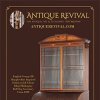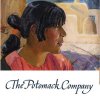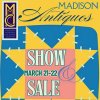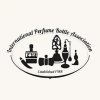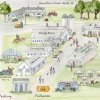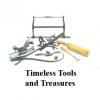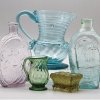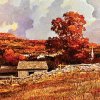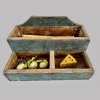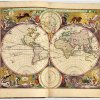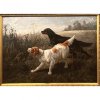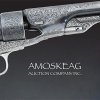ADA/Historic Deerfield Antiques Show
October 11th, 2015
Deerfield, Massachusetts
The ADA/Historic Deerfield Antiques Show, held over the weekend of October 10 and 11, 2015, at Deerfield Academy in Deerfield, Massachusetts, was an ideal antiques show. Just 39 dealers exhibited. All are members of the Antiques Dealers’ Association of America, formed more than 30 years ago to ensure the highest standards. Every item was labeled with its age, origin, condition, restoration if any, and the price. Authenticity was guaranteed.
Moreover, the setting in Historic Deerfield allowed for immersion in the Colonial world and helped all of those sensitive to the pleasures of earlier times get in the mood to take home antiques that give so much satisfaction.

The ADA/Historic Deerfield Antiques Show, held at Deerfield Academy in Massachusetts at the peak of autumn, is a perfect time to tour the historical houses at Historic Deerfield, the Flynt Center of Early New England Life, with its brilliant exhibition of woods and construction of American furniture, and Memorial Hall, with its collection of Hadley chests, Native American artifacts, and Deerfield history.
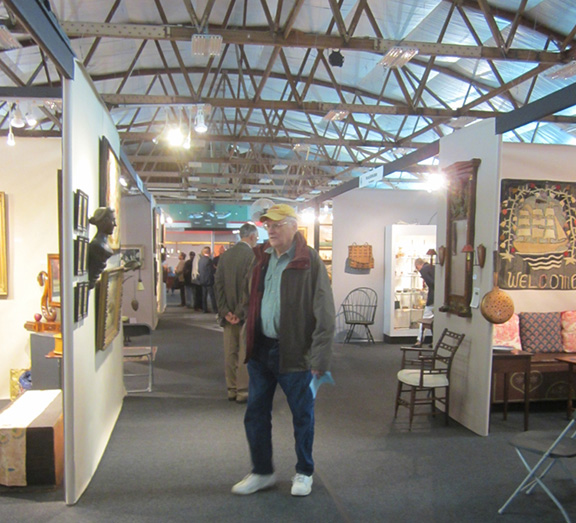
It was crowded on Saturday, and people stayed for several hours. The aisles were wide, the light was good, and the space was pleasant and airy with several walk-through stands for easy circulation.
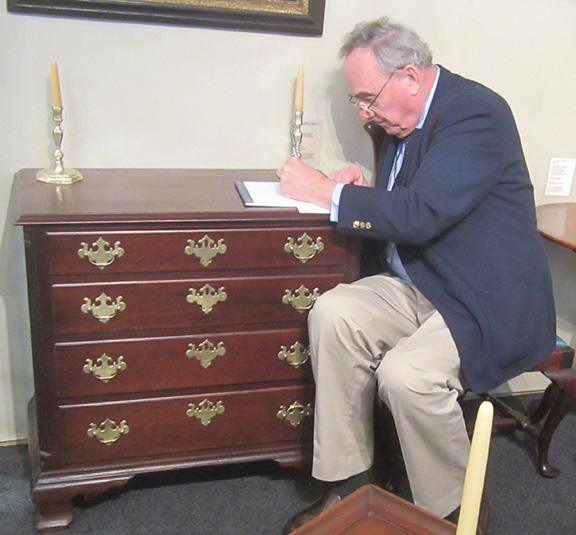
Business was done. Litchfield, Connecticut, dealer Jonathan Trace writes up a sale ticket. He sold silver and brass.
The show’s strength is in high-country antiques. There was not much high-style material on view, but there was plenty of folk art, including portraits, watercolors, painted chests and boxes, textiles, ceramics, and treen. One could have put together a first-rate collection of burl bowls, New England redware, cobalt-decorated stoneware, English delft, and lanterns, plus found plenty of cupboards and tables to show them off and nice rugs for the floor.
The well-attended show has a loyal following. “This is my favorite show,” said Wellesley, Massachusetts, dealer Bill Samaha.
“I like it I better than the shows in Manchester because it is so focused; people are not distracted going from place to place. It is not so hectic,” agreed Groton, Massachusetts, dealer Martha Boynton.
“I drove down with my father from Toronto,” said one young woman. “He wouldn’t miss this show.” Neither would a lot of others.
 It is a slow-paced show; people come and stay all day. They may go to the Flynt Center of Early New England Life or visit some of the historic houses on Deerfield’s Main Street for an hour or two and then come back to the show. They stay engaged. One group comes on Saturday and another on Sunday; most are New Englanders, but a few came from the Middle Atlantic States, and at least one committed collector came from the Midwest. The ADA posts a long list of places to stay, many of them bed-and-breakfasts. This is a destination show, but what a destination! The autumn color was a bit disappointing, as the leaves were just beginning to turn gold and orange. The locals said color was delayed because of the long, cold winter.
It is a slow-paced show; people come and stay all day. They may go to the Flynt Center of Early New England Life or visit some of the historic houses on Deerfield’s Main Street for an hour or two and then come back to the show. They stay engaged. One group comes on Saturday and another on Sunday; most are New Englanders, but a few came from the Middle Atlantic States, and at least one committed collector came from the Midwest. The ADA posts a long list of places to stay, many of them bed-and-breakfasts. This is a destination show, but what a destination! The autumn color was a bit disappointing, as the leaves were just beginning to turn gold and orange. The locals said color was delayed because of the long, cold winter.
Some dealers sent out e-mail blasts to their customers, and it made a difference. Shaker collectors were offered the ADA show on Saturday morning, a talk at Hancock Shaker Village in Pittsfield, Massachusetts, on Saturday afternoon, and a dinner served in the Shaker dining rooms. Then on Sunday there were specialized hands-on tours of the Shaker collections at Hancock Shaker Village and a preview for the Willis Henry Shaker auction to be held there on Monday. It was promoted as a package by Marshfield, Massachusetts, auctioneer Willis Henry; the Hancock Shaker Village; and South Salem, New York, Shaker dealer John Keith Russell, whose booth was front and center at the ADA show. Russell did a good bit of business as a result of this gathering of Shaker collectors.
Half a dozen dealers at the show sold very well. The gate was up 20% on Saturday, and some people said interest was up and so was the quality. Many good things were available, and they were more affordable than in the past. Preshow business was good. Dealers who said sales were slow were hoping for callbacks, which can take weeks or even months. The success of a show can’t be judged on the number of sales because networking at shows results in future business. Exhibiting at a show is a good form of advertising.

Bernard & S. Dean Levy, New York City, asked $35,000 for this Connecticut River valley sideboard with unusual inlay. Some thought it was made in Vermont. The knife boxes are English.

John Keith Russell of South Salem, New York, asked $135,000 for the circa 1840 Shaker trestle table with a two-board top, 28" high x 90¼" long x 33" wide, with a record of use in Canterbury, New Hampshire, though it may have been made in Watervliet, New York. The sisters’ tailoring counter is paneled on all sides and is on rollers for easy moving; it sold. The chair on the back wall was made of highly figured maple with a caned seat and is one of a handful known with pewter tilters; from the Faith and Edward Deming Andrews collection, it cost $37,000. The Shaker bed wrench was $975. The green-painted chest on the left sold, as did the oval boxes on the table.
The two low-back chairs at far left, one on the wall and one on the floor, are from a set of eight in original paint made in 1832 by Brother Macijah Tucker for the Shaker community at Canterbury, New Hampshire. They are low so they can be pushed under a trestle table when not in use. Russell priced the set of eight at $26,500.

This Philadelphia or English Regency center table with well-matched mahogany veneer—it also tips up—was $11,500 from Thomas Schwenke of Woodbury, Connecticut. The Federal mahogany server (back left), attributed to Duncan Phyfe, 1810-15, 56" high x 51" wide x 21½" deep, was $11,000. The Connecticut chest of cherry with four graduated cockbeaded drawers, fluted quarter columns, ogee bracket feet, and original brasses (back right) was from the Hartford area and priced at $5500.
Three dealers were new to the show: ceramics dealer Paul Vandekar of Maryknoll, New York; American furniture dealer Frank Levy of New York City; and Jerry Jordan of Dorset, Vermont, who deals in broadsides and ephemera. According to show manager Karen DiSaia, all the dealers want to return next year, and a few who had health problems hope to be back too.
The floor plan with walk-through booths allowed for wide aisles, no dead walls, and something to see at every turn. Moreover, the lighting was not blinding. DiSaia said it is a show put on by dealers, who all pitch in, and the booth rent is reasonable; the gate goes to Historic Deerfield.
The photos and captions show some of what was there. For more information, visit the ADA’s website (www.adadealers.com) or call (603) 942-6498.

This Massachusetts cherry chest of drawers with overhanging molded edge, four graduated drawers, high bracket feet, an old refinish, and replaced brasses was $2200 from Ted Fuehr of American Spirit Antiques, Shawnee Mission, Kansas. The Federal tiger maple footstool with ring-turned legs and ball feet, upholstered over the frame, 13¾" x 6½", probably Pennsylvania, was priced at $700.

Gardner, Massachusetts, dealer Rex Stark bought this patriotic quilt from Scott Bassoff - Sandy Jacobs Antiques, Swampscott, Massachusetts.

This extraordinary wool embroidered blanket, made for Susanna Thompson of Winfield, New York, and dated 1826, was $28,500 from Jewett-Berdan Antiques, Newcastle, Maine.

This slide-lid box painted with a stylized bowl of fruit on a pink ground was attributed to Ransom Cook of Saratoga, New York, by Richard Axtell of Deposit, New York, who dated it to circa 1830 and offered it at $30,000.

Scrimshaw sewing basket, $15,000 from Paul DeCoste of West Newbury, Massachusetts.
Originally published in the January 2016 issue of Maine Antique Digest. © 2015 Maine Antique Digest
